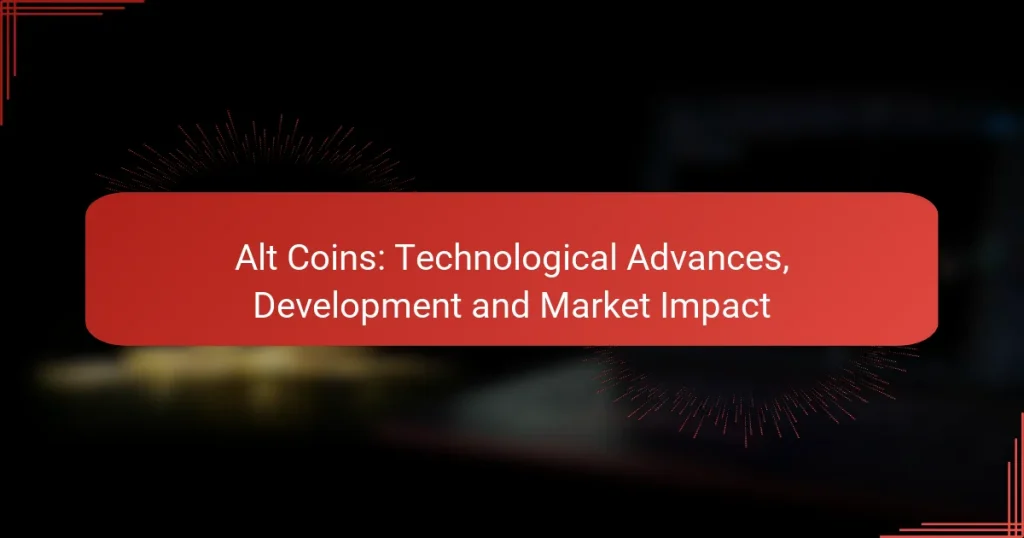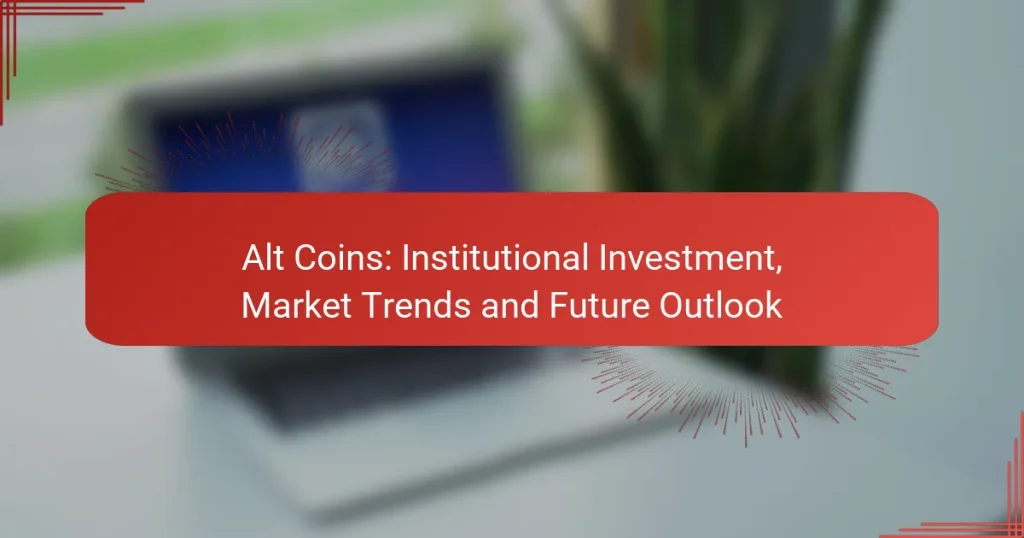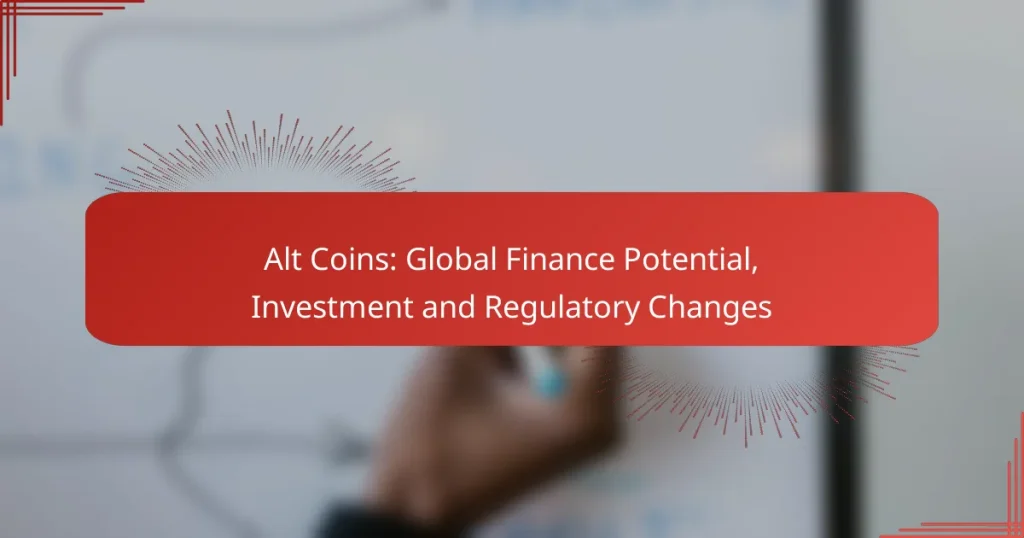The future of cryptocurrency altcoins is poised for significant growth as 2024 approaches, with several promising options like Ethereum, Cardano, and Solana capturing investor interest. As institutional adoption increases and innovative use cases emerge, altcoins are becoming more relevant in the evolving financial landscape. However, potential investors must remain cautious of the inherent risks, including market volatility and regulatory challenges, that accompany these investment opportunities.
Alt Coins: Technological Advances, Development and Market Impact
Alt Coins: Institutional Investment, Market Trends and Future Outlook
Alt Coins: Market Trends, Future Impact and Investment Opportunities
Alt Coins: Regulatory Changes, Evolution and Market Adaptation
Alt Coins: Global Finance Potential, Investment and Regulatory Changes
What are the top cryptocurrency altcoins to invest in 2024?
In 2024, several altcoins are gaining traction as potential investment opportunities. Key players include Ethereum, Cardano, Solana, Polkadot, and Chainlink, each offering unique features and use cases that may appeal to investors.
Ethereum (ETH)
Ethereum remains a leading altcoin due to its robust smart contract functionality and widespread adoption. Its transition to a proof-of-stake model has improved scalability and energy efficiency, making it more attractive for developers and investors alike.
Investors should consider Ethereum’s ongoing upgrades, such as sharding, which aim to enhance transaction speeds and reduce costs. Keeping an eye on Ethereum’s ecosystem developments can provide insights into its future performance.
Cardano (ADA)
Cardano is recognized for its research-driven approach and strong emphasis on security and sustainability. Its proof-of-stake consensus mechanism allows for efficient transactions while minimizing energy consumption.
Investors should evaluate Cardano’s partnerships and real-world applications, particularly in sectors like education and supply chain management. These factors may influence its growth potential in the coming year.
Solana (SOL)
Solana has gained popularity for its high throughput and low transaction fees, making it a strong contender in the decentralized finance (DeFi) space. Its unique architecture allows for thousands of transactions per second, appealing to developers seeking efficiency.
Investors should be mindful of Solana’s rapid growth and the potential for network congestion during peak times. Monitoring its ecosystem and user adoption can help gauge its investment viability.
Polkadot (DOT)
Polkadot stands out for its interoperability, allowing different blockchains to communicate and share information. This feature positions it as a key player in the multi-chain future of blockchain technology.
Investors should consider Polkadot’s parachain auctions, which enable projects to secure a slot on the network. Understanding the projects that win these slots can provide insights into potential growth areas within the Polkadot ecosystem.
Chainlink (LINK)
Chainlink is essential for connecting smart contracts with real-world data, making it a critical infrastructure component for many blockchain applications. Its decentralized oracles enhance the reliability of data used in smart contracts.
Investors should look at Chainlink’s partnerships and integrations with various blockchains and enterprises. These collaborations can significantly impact its adoption and value in the cryptocurrency market.
How are altcoins evolving in the current market?
Altcoins are evolving rapidly, driven by increased institutional interest, integration with decentralized finance (DeFi) platforms, and the emergence of innovative use cases. These factors are reshaping the landscape of cryptocurrency, making altcoins more relevant and accessible to a broader audience.
Increased adoption by institutions
Institutional adoption of altcoins has surged, with many companies and investment funds diversifying their portfolios beyond Bitcoin. Major financial institutions are now offering altcoin trading and custody services, which enhances credibility and liquidity in the market.
For example, firms like Grayscale and Fidelity have introduced altcoin investment products, allowing investors to access a wider range of digital assets. This trend is likely to continue as more institutions recognize the potential of altcoins for growth and diversification.
Integration with DeFi platforms
Altcoins are increasingly being integrated into DeFi platforms, which allow users to lend, borrow, and trade without intermediaries. This integration enhances the utility of altcoins, as they can be used for yield farming, liquidity provision, and other DeFi activities.
Popular altcoins like Ethereum and Chainlink are foundational to many DeFi applications, enabling smart contracts and decentralized exchanges. As DeFi continues to grow, the demand for altcoins that support these ecosystems is expected to rise.
Emergence of new use cases
New use cases for altcoins are emerging, driven by technological advancements and market needs. For instance, some altcoins are focusing on privacy features, while others are developing solutions for supply chain management or digital identity verification.
Projects like VeChain and Monero illustrate how altcoins can address specific challenges in various industries. As these use cases gain traction, they can attract new users and investors, further solidifying the role of altcoins in the cryptocurrency market.
What are the risks associated with investing in altcoins?
Investing in altcoins carries several risks that potential investors should carefully consider. These include market volatility, regulatory challenges, and security vulnerabilities that can significantly impact the value and safety of investments.
Market volatility
Altcoins are known for their extreme price fluctuations, often experiencing rapid increases and steep declines. This volatility can be influenced by market sentiment, news events, and trading volumes, making it essential for investors to be prepared for sudden changes in value.
For example, an altcoin may surge by 50% in a single day due to positive news but could just as easily drop by 30% the next day. Investors should assess their risk tolerance and consider setting stop-loss orders to mitigate potential losses.
Regulatory challenges
The regulatory landscape for cryptocurrencies, including altcoins, is still evolving and can vary significantly by country. Changes in regulations can impact the legality and trading of certain altcoins, leading to potential losses for investors.
For instance, a government may impose restrictions on the use of specific altcoins or classify them as securities, which could affect their market performance. Staying informed about regulatory developments in your jurisdiction is crucial for making informed investment decisions.
Security vulnerabilities
Altcoins can be susceptible to various security issues, including hacking, fraud, and technical flaws. These vulnerabilities can lead to significant losses if an investor’s holdings are compromised or if the altcoin itself fails due to poor security practices.
Investors should prioritize using reputable exchanges and wallets, enabling two-factor authentication, and keeping their software updated to reduce the risk of security breaches. Regularly reviewing the security measures of the altcoins in which they invest can also help mitigate these risks.
What criteria should be used to evaluate altcoins?
To effectively evaluate altcoins, consider their market capitalization, technology and use case, and the reputation of their development team. These criteria help determine the potential value and viability of an altcoin in the competitive cryptocurrency landscape.
Market capitalization
Market capitalization reflects the total value of an altcoin and is calculated by multiplying the coin’s current price by its circulating supply. A higher market cap often indicates greater stability and investor confidence, while lower market caps can suggest higher volatility and risk.
When evaluating altcoins, look for those with market capitalizations in the mid-range, as they may offer a balance between growth potential and risk. For instance, altcoins with market caps in the hundreds of millions to low billions of USD can be more promising than those with very low or excessively high caps.
Technology and use case
The underlying technology and practical use case of an altcoin are crucial for its long-term success. Assess whether the altcoin solves a specific problem or improves upon existing technologies. For example, some altcoins focus on enhancing transaction speed, while others aim to provide privacy or decentralized finance solutions.
Research the technology behind the altcoin, including its consensus mechanism and scalability. Altcoins that utilize innovative technologies, such as proof-of-stake or layer-2 solutions, may have a competitive edge in the market.
Development team reputation
The reputation of the development team behind an altcoin can significantly influence its credibility and potential for success. Investigate the team’s background, experience, and previous projects to gauge their expertise in the cryptocurrency space.
Look for transparency in communication and regular updates from the development team. A strong community presence and active engagement can indicate a dedicated team that is committed to the altcoin’s growth and improvement.
How do altcoin trends differ across regions?
Altcoin trends vary significantly across regions due to differences in regulatory environments, market maturity, and technological adoption. Understanding these regional variations can help investors make informed decisions about where to focus their altcoin investments.
North America vs Europe
In North America, particularly the United States, altcoin trends are influenced by a relatively mature market and a complex regulatory landscape. Investors often prioritize established altcoins with strong use cases, such as Ethereum and Litecoin, while also exploring emerging projects. The regulatory scrutiny can lead to a cautious approach, with many investors favoring coins that comply with local laws.
In contrast, Europe showcases a more diverse altcoin landscape, with countries like Germany and Switzerland leading in innovation and acceptance. The European Union’s regulatory framework is evolving, which encourages a broader range of altcoins. Investors here may be more open to experimenting with newer projects, especially those that emphasize sustainability and social impact.
Asia-Pacific innovations
The Asia-Pacific region is a hotbed for altcoin innovation, with countries like China, Japan, and South Korea at the forefront. These markets often see rapid adoption of new technologies and concepts, such as decentralized finance (DeFi) and non-fungible tokens (NFTs). Investors are typically more willing to take risks on new altcoins, driven by a culture of technological advancement and a younger demographic.
However, regulatory challenges can vary widely within the region. For instance, while Japan has established clear regulations for cryptocurrencies, China has imposed strict bans on crypto trading. This creates a dynamic environment where investors must stay informed about local regulations and market conditions to navigate the altcoin landscape effectively.





